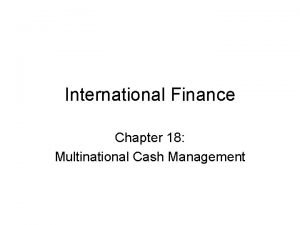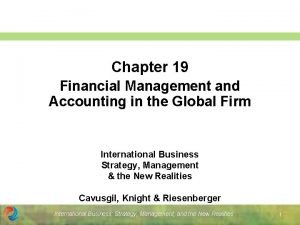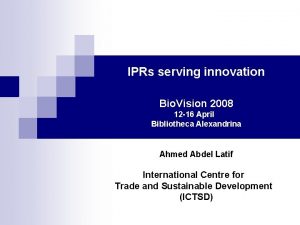IPRs and Innovation August 10 2016 Multilateral agreements

















- Slides: 17

IPRs and Innovation August 10, 2016

Multilateral agreements Berne Convention, 1886 - protection to literary and artistic works. Revised seven times in 1896 (at Paris), 1908 (at Berlin), 1928 (at Rome), 1948 (at Brussels) , 1967 (at Stockholm) and 1971 (at Paris) and finally in 1978. The 1971 revision (the Paris Act) is of particular importance to the developing countries Provides special concessions to these countries in making translations and reproduction of foreign literary works for educational purposes. Ninety countries are at present member of the Berne Convention. In August, 1952 the Universal Copyright Convention (UCC). India is a member of both the Berne Convention and the UCC.

In India too legislation has supported IP 1876, 1963 – Dramatic Performances Act 1914, 1957 – Copyright Act 1918, 1952 – Cinematograph Act 1981 – Cine-workers welfare Cess Act, Cineworkers welfare Fund Act, Cine-workers and Cinema Theatre workers (Regulation of Employment) Act. 1995 – Cable Television Networks (Regulation) Act

TRIPS stipulates standardization of IPRs across countries to ensure minimum standards 1. Patents 2. Copyrights and related rights 3. Trademarks 4. Geographic indications 5. Trade secrets 6. Layout-designs (Topographies) of Integrated Circuits (Semiconductor Mask Works) 7. Industrial Designs

The classic North-South divide in innovation North South Developed economies Emerging economies Source of technology and innovation Acquire technology through transfers or imitation Demand for better IPRs to ensure ROI on R&D investments IPR protection to foster growth

What role do intellectual property rights play in promoting innovation and therefore driving growth in the knowledge economy?

Structure of our analysis Innovation - the amalgamation of new ventures with creative insights that leads to generation of social and economic value. Level of innovation is quantified as the number of IPRs registered by a specific nation/state. Study the various factors that drive innovation in the economy and their role in driving innovation

Extensive data collation 133 countries 123 years Total number of patent application/granted Macro-economic variables (GDP, growth, FDI, …) IT and Infrastructure variables Policy/Business metrics

Changing world order in Innovation 1980 1990 2000 2014 China 0% 1% 4% 20% 35% United States of America 13% 17% 22% 25% 22% Japan 23% 37% 30% 17% 12% Republic of Korea 1% 3% 7% 9% 8% Germany 6% 4% 5% 3% 2% India 0% 0% 1% 2% 2% Russian Federation 0% 0% 2% 2% 2% Canada 3% 3% 3% 2% 1% Brazil 1% 1% 1% Australia 2% 0% 2% 1% 1%

FDI and growth show no clear relationship with Innovation Patents vs. GDP Growth% Patents vs. FDI

Innovation is related to higher incomes Patents vs. Per Capita GDP Correlation between pc income and patents increased from 10% to 44% over the last 26 years Direction of causality unclear

Innovation becomes a self sustaining habit Legacy is the strongest factor

Summary of Findings… Innovation does not depend on growth percentages but does tend to be focused in hubs There is a clear relationship between wealth and innovation; but no clear direction of causality… Openness of an economy and a legacy key to putting the economy on a path to higher innovativeness

Corroborating the findings on Innovation within India Controller General of Patents, Designs, Trade Marks and Registrar of Geographical Indications

India in the positive spiral of innovation India improves score – 7. 23 from 6. 95 Increased IPR protection translates to higher firm level R & D spending The Copyright software protection a step forward Make in India: IP an important component and so says the PM

Lots to do on IP to foster Innovation Software product patents, no clarity. Copyrights implementation is poor, with delays in the legal process Patenting is complicated – not just novelty, usefulness and non obviousness but also Inventive step and Capable of industrial application

Discussions…
 Iprs limited
Iprs limited Iprs limited
Iprs limited Nc innovations waiver emergency slot
Nc innovations waiver emergency slot Innovation for the sake of innovation
Innovation for the sake of innovation Radical vs disruptive innovation
Radical vs disruptive innovation Remote peering in osaka
Remote peering in osaka Xxx
Xxx Multilateral competition games
Multilateral competition games Netting in finance
Netting in finance The multilateral security enforces access control
The multilateral security enforces access control Unilateral competition games examples
Unilateral competition games examples Bagan kerjasama multilateral
Bagan kerjasama multilateral Multilateral netting is used primarily to
Multilateral netting is used primarily to Expand the pie negotiation
Expand the pie negotiation Yalta conference agreements
Yalta conference agreements Unanimous agreements npc
Unanimous agreements npc What are international hardwood agreements
What are international hardwood agreements Vendor rebate agreement
Vendor rebate agreement
































